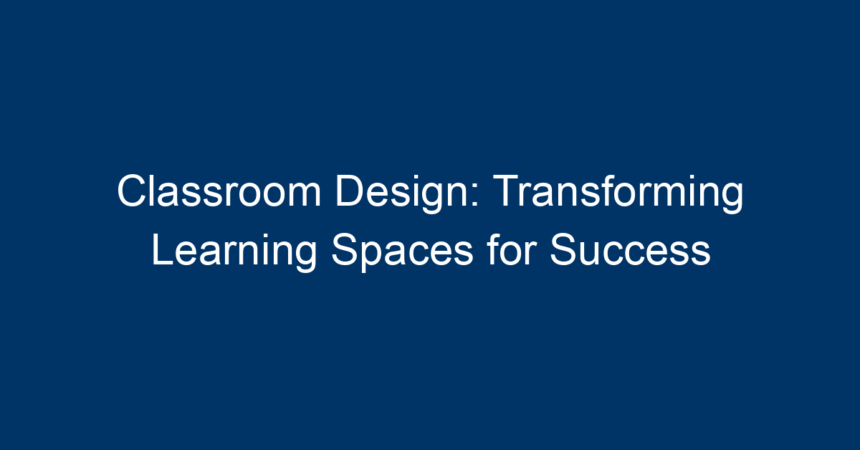In today’s rapidly evolving educational landscape, the importance of classroom design cannot be overstated. More than just a physical space, a well-designed classroom can significantly impact student engagement, learning outcomes, and overall satisfaction. As educators and school leaders seek to foster environments that promote student growth, understanding the principles of effective classroom design is essential. This article explores the critical aspects of classroom design, its impact on learning, and actionable insights for transforming learning spaces for success.
The Power of Classroom Design
Classroom design encompasses various elements from layout and color schemes to furniture and technology integration. Each component plays a crucial role in how students interact with their environment and engage with learning materials.
The Impact of Environment on Learning
Research indicates that a thoughtfully designed classroom can enhance focus, improve retention rates, and foster collaboration. The physical environment affects not only how students feel but also how they learn. Colors, lighting, and spatial arrangement can create a welcoming atmosphere that encourages exploration and innovation.
The Role of Flexibility
As learning styles evolve, classrooms must adapt to accommodate diverse needs. Flexible classroom design includes movable furniture, versatile layouts, and multipurpose spaces that can be reconfigured for different activities, ranging from group projects to individual study sessions. This adaptability fosters a sense of ownership among students, empowering them to take charge of their learning.
Key Elements of Effective Classroom Design
To create a transformative learning environment, educators must consider various elements:
Layout and Spacing
Open Spaces vs. Defined Areas
A traditional classroom layout often constrains movement and interaction. Instead, a blend of open spaces and defined learning areas encourages collaboration. For instance, using clusters of desks can facilitate group work, while designated quiet zones can support individual study.
Zones for Different Activities
Incorporating different zones within the classroom—such as collaborative areas, individual workspaces, and areas for technology integration—allows for a more dynamic learning experience. This approach caters to various learning preferences and activities, enhancing engagement.
Furniture Selection
Ergonomics Matters
Investing in ergonomic furniture is crucial for creating a comfortable learning environment. Desks and chairs that promote good posture can significantly reduce distractions and discomfort, allowing students to focus on their studies.
Versatile Options
Choosing furniture that can be easily rearranged fosters collaboration and creativity. For instance, using tables that can be combined for group activities or separated for individual work facilitates a more adaptable learning environment.
Color and Aesthetics
Color Psychology in the Classroom
Color has a profound impact on mood and concentration. Opting for soft, calming colors like blues and greens can promote focus, while energizing tones like yellow can inspire creativity. Careful consideration of color palettes can enhance the emotional well-being of students.
Personalization and Student Input
Involving students in the aesthetic aspect of classroom design can foster a sense of ownership. Allowing them to suggest color schemes or decorations creates a community feeling, enhancing their emotional connection to the learning environment.
Technology Integration
Smart Classrooms
In today’s digital age, technology plays an integral role in education. A successful classroom design incorporates smart technology like interactive whiteboards, tablets, and multimedia projectors. This not only enriches the learning experience but also prepares students for the tech-driven world.
Wireless Connectivity
Ensuring that classrooms are equipped with reliable wireless connectivity is essential for integrating technology seamlessly. This facilitates group projects, research tasks, and online learning opportunities, enabling students to engage in a more enriching educational experience.
Designing for Diverse Learners
Inclusion and Accessibility
Effective classroom design goes beyond aesthetics and functionality—it also embraces inclusivity. Classrooms must be designed to accommodate students with diverse learning needs, including those with physical disabilities or varying mental health conditions. This includes:
- Wide pathways for wheelchair access.
- Adjustable furniture that can be customized for different height and comfort levels.
- Sensory areas that offer calming or stimulating experiences, supporting students with sensory processing needs.
Cultural Responsiveness
Classroom design should reflect the diversity of the student body. Incorporating elements that celebrate various cultures—through artwork, textiles, or literature—can create an inviting environment that acknowledges and values each student’s background.
The Role of Teachers in Classroom Design
Teacher Collaboration
Effective classroom design is not a solo endeavor. Collaboration among teachers is vital for sharing best practices and insights. Engaging in discussions about design principles can ultimately lead to a more enhanced teaching approach.
Professional Development
Training sessions focusing on effective classroom design strategies and principles can empower educators to make informed decisions. Investing in professional development ensures that teachers have the tools and knowledge needed to implement effective designs.
Measuring the Impact of Classroom Design
Feedback Mechanisms
Implementing feedback mechanisms, such as surveys or focus groups, allows educators to assess the effectiveness of the classroom design. Gathering student insights can unveil areas for improvement and encourage ongoing enhancements.
Academic Performance Indicators
Monitoring academic performance data in conjunction with classroom design changes can provide concrete evidence of success. By analyzing test scores, engagement levels, and attendance rates, educators can determine the impact of their design choices.
Conclusion: Transforming Learning Spaces for Success
The importance of classroom design extends beyond mere aesthetics; it fundamentally shapes the educational experience. By understanding the impact of layout, furniture, colors, and technology, educators can create spaces that empower students and foster successful learning outcomes.
Actionable Insights
-
Assess Your Current Classroom Environment: Identify strengths and weaknesses in your existing layout and resources.
-
Involve Students in Design Decisions: Foster ownership by allowing students to contribute ideas on the aesthetic and functional aspects of the classroom.
-
Invest in Flexible Furniture: Consider moving away from traditional desks and chairs to more versatile options that promote collaboration.
-
Incorporate Technology Thoughtfully: Ensure that any technological integration is user-friendly and enhances, rather than distracts from, the learning experience.
- Regularly Review and Iterate: Make classroom design a living process; gather feedback, analyze academic outcomes, and be prepared to iterate on designs for ongoing improvement.
With thoughtful consideration and a willingness to innovate, educators can transform classrooms into thriving learning centers that equip today’s students for success in an ever-evolving world.




